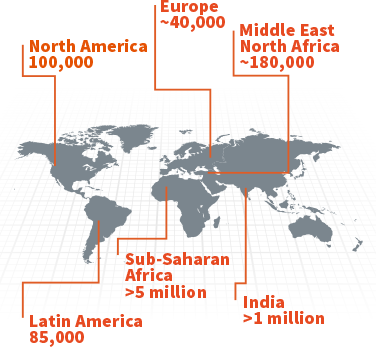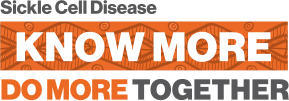
You are
not alone

~300,000,000
People have the sickle cell trait*
~6,400,000
People living with sickle cell disease†
~300,000
Children born each year
with sickle cell disease†
*People who carry the sickle cell trait have 1 normal haemoglobin gene and 1 sickle haemoglobin gene.
†People who have sickle cell disease have 2 sickle haemoglobin genes and will most likely experience symptoms of sickle cell disease.
Many other people are affected by sickle cell disease
Sickle cell disease is an inherited disease and is one of the most common genetic blood disorders in
the world.
The sickle cell gene originated thousands of years ago in areas where malaria was, and continues to be, widespread. Because of its origin in Africa, sickle cell disease primarily affects people of African ancestry. It was later established that the sickle cell gene can be protective against malaria.
Due to migration patterns, people with Mediterranean, Middle Eastern, Caucasian, Indian, Hispanic, Native American, and other ancestries can also be affected.

Migration is changing the sickle cell disease landscape
As people move, or migrate, from their country of origin, sickle cell disease is having an impact on different areas of the world, such as North and South America, and Europe.
From 2010 to 2050, the number of children born with sickle cell disease is expected to grow by 30% around the world.
Myths and facts about sickle cell disease
As awareness of sickle cell increases around the world, it’s important to challenge the myths about the condition. The following myths are common and can affect people who live with the disease, their families and caregivers, friends, and health care providers. Click on a myth below to see the underlying fact.
Myth: Only people of African ancestry can have sickle cell disease
Fact: While sickle cell disease mostly affects those of African ancestry, it also affects people from different regions around the world.
Myth: Sickle cell disease is contagious
Fact: Sickle cell disease is an inherited blood disorder; the condition is not contagious at all! It can only be passed from birth parents to their children.
Myth: Sickle cell disease is a short-term condition
Fact: Although some pain crises may be short-lived, people who have sickle cell disease have it at birth and will have it their entire lives.
Myth: There is only one type of sickle cell disease
Fact: There are actually several types of sickle cell disease, including, but not limited to, HbSC, HbS β‑thalassemia, and HbSS, the most common form of the condition.
Myth: Sickled red blood cells are the only cause of pain crises
Fact: There’s more to the story than just sickled cells. Pain crises are actually the result of how sickle cell disease affects other components of the body’s blood system, not just red blood cells.
Myth: People with sickle cell disease seek out pain medicine, even though they don’t need it
Fact: Pain crises, which can be severe and require medical intervention, are a common complication of sickle cell disease. These pain crises often require prescription pain medicine to provide relief.
Myth: People with sickle cell disease are unmotivated and lack initiative
Fact: Sickle cell disease can affect the body, mind, and overall life of people with the condition. There are health issues, such as fatigue and anxiety, which may be misunderstood by others who do not know the symptoms of sickle cell disease.









